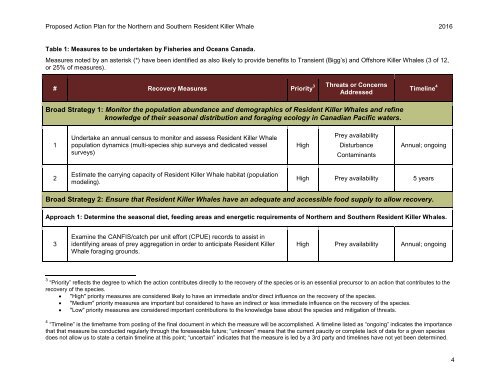Resident Killer Whale
Ap-KillerWhale-v00-2016Jun13-Eng
Ap-KillerWhale-v00-2016Jun13-Eng
Create successful ePaper yourself
Turn your PDF publications into a flip-book with our unique Google optimized e-Paper software.
Proposed Action Plan for the Northern and Southern <strong>Resident</strong> <strong>Killer</strong> <strong>Whale</strong> 2016<br />
Table 1: Measures to be undertaken by Fisheries and Oceans Canada.<br />
Measures noted by an asterisk (*) have been identified as also likely to provide benefits to Transient (Bigg’s) and Offshore <strong>Killer</strong> <strong>Whale</strong>s (3 of 12,<br />
or 25% of measures).<br />
3 Threats or Concerns<br />
# Recovery Measures Priority<br />
Addressed<br />
Timeline 4<br />
Broad Strategy 1: Monitor the population abundance and demographics of <strong>Resident</strong> <strong>Killer</strong> <strong>Whale</strong>s and refine<br />
knowledge of their seasonal distribution and foraging ecology in Canadian Pacific waters.<br />
1<br />
Undertake an annual census to monitor and assess <strong>Resident</strong> <strong>Killer</strong> <strong>Whale</strong><br />
population dynamics (multi-species ship surveys and dedicated vessel<br />
surveys)<br />
High<br />
Prey availability<br />
Disturbance<br />
Contaminants<br />
Annual; ongoing<br />
2<br />
Estimate the carrying capacity of <strong>Resident</strong> <strong>Killer</strong> <strong>Whale</strong> habitat (population<br />
modeling).<br />
High Prey availability 5 years<br />
Broad Strategy 2: Ensure that <strong>Resident</strong> <strong>Killer</strong> <strong>Whale</strong>s have an adequate and accessible food supply to allow recovery.<br />
Approach 1: Determine the seasonal diet, feeding areas and energetic requirements of Northern and Southern <strong>Resident</strong> <strong>Killer</strong> <strong>Whale</strong>s.<br />
3<br />
Examine the CANFIS/catch per unit effort (CPUE) records to assist in<br />
identifying areas of prey aggregation in order to anticipate <strong>Resident</strong> <strong>Killer</strong><br />
<strong>Whale</strong> foraging grounds.<br />
High Prey availability Annual; ongoing<br />
3 “Priority” reflects the degree to which the action contributes directly to the recovery of the species or is an essential precursor to an action that contributes to the<br />
recovery of the species.<br />
"High" priority measures are considered likely to have an immediate and/or direct influence on the recovery of the species.<br />
"Medium" priority measures are important but considered to have an indirect or less immediate influence on the recovery of the species.<br />
"Low" priority measures are considered important contributions to the knowledge base about the species and mitigation of threats.<br />
4 “Timeline” is the timeframe from posting of the final document in which the measure will be accomplished. A timeline listed as “ongoing” indicates the importance<br />
that that measure be conducted regularly through the foreseeable future; “unknown” means that the current paucity or complete lack of data for a given species<br />
does not allow us to state a certain timeline at this point; “uncertain” indicates that the measure is led by a 3rd party and timelines have not yet been determined.<br />
4


